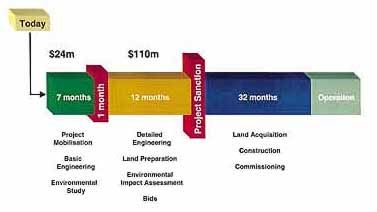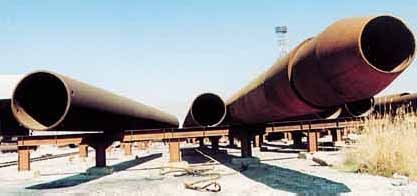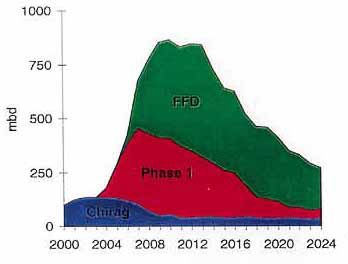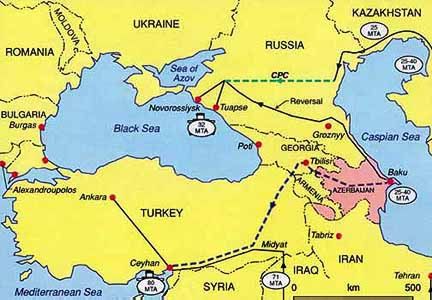|

Summer 2001 (9.2)
Petroleum Section
Progress
on the Main Export Pipeline
Interview with David
Woodward
Associate President, BP Azerbaijan
by Betty Blair
  It seems like everybody
in Baku is hanging around waiting for the pipeline route to be
decided upon and, of course, ultimately built. What's happening
these days? What stage is the process at right now? It seems like everybody
in Baku is hanging around waiting for the pipeline route to be
decided upon and, of course, ultimately built. What's happening
these days? What stage is the process at right now?
We have made a lot of progress on the Baku-Tbilisi-Ceyhan (BTC)
[spelled through Turkish, but pronounced Jeyhan in English] pipeline
this last year. We have now concluded the three HGAs (Host Government
Agreements) with Turkey, Georgia and Azerbaijan. In 1999, we
had finished the agreement with Turkey. Then it took us quite
a while to carry out extensive negotiations with Georgia covering
the environmental standards, security issues and commercial terms
of the pipeline construction through that country. We signed
with them during the second quarter of 2000. Then we were able
to quickly finalize the HGA with Azerbaijan.
Subsequently, we had to establish a group of companies that were
ready to get involved with the first stage of the project - the
Basic Engineering stage. At that time, we got agreement from
six other AIOC partners (Statoil, Unocal, TPAO, ITOCHU, Delta
Hess and Ramco) to join BP and SOCAR in what we call a "Sponsor
Group" to undertake the initial stages of the project.
Discussions with other companies, including Chevron and Total
Fina Elf, continue to see whether they would be interested in
joining the Sponsor Group, or perhaps be prepared to ship their
oil volumes through the pipeline rather than be investors in
it. We are interested in both types of cooperation - investors
and shippers of oil.
We signed an agreement forming the Sponsor Group with SOCAR (State
Oil Company of Azerbaijan Republic) and the HGAs with the host
governments on October 16, 2000.
It was really quite a significant milestone, I must say, after
so many years of discussions. It signified that we were ready
to spend serious sums of money on Basic Engineering, develop
the legal and commercial aspects of the pipeline company that
we expect will be formed, and start looking at how to secure
external financing for the project.
After this work finishes towards the end of May 2001, we have
a month in which to decide whether to proceed to the next stage
- Detailed Engineering - which would take 12 months to complete.
In that stage, we would complete the engineering design of the
pipeline, pump stations, terminals and so on and invite tenders
for the supply of materials and equipment, and construction services.
When will the exact route be determined?
We're selecting the route right now during the Basic Engineering
phase. This process involves looking at the environmental impact
as well as the social impact of the pipeline, to determine how
it might affect communities along the pipeline route. We also
have to consider if the areas where we want to lay the pipeline
are safe and if the facilities can be protected.

Above: Proposed timeline for
the planning and construction of the Baku-Tbilisi-Ceyhan (BTC)
pipeline.
What's involved when you consider the environmental impact of
the pipeline?
We undertake what we call an Environmental Impact Assessment
(EIA) as well as a Social Impact Assessment (SIA). Clearly we
want to avoid particularly sensitive areas - regions of outstanding
natural beauty or areas where construction activity or any potential
oil leak at any stage of the operation would have an unacceptable
impact on the environment. We are obviously looking at where
there are aquifers of drinking water and making sure that construction
activity is well clear of those areas.
We do a tremendous amount of consulting with government agencies,
non-governmental agencies and the public to learn about their
concerns. Ultimately, we have to gain approval from the government
as to the exact route of the pipeline, and we have to indicate
which criteria we have used to decide upon that specific route.
The government then consults with its own experts for advice
about any sensitivity in particular areas.
And the Social Impact Assessment?
We have to be concerned about the impact of the pipeline, particularly
in populated areas. We want to minimize the need to move people's
houses and we want to avoid disrupting farming activities as
well, not just when we are operating the line, but also when
we are constructing it, especially since we have to move in materials,
all of the pipe and other equipment.
Thousands of truck loads of equipment will need to be brought
in, so we have to consider which roads to use so we don't present
a hazard for any particular community. In situations where we
do anticipate difficulties, we have to ask ourselves if there
is any way we can avoid these by choosing a different route.

Above: Much of the proposed
pipeline will use 42-inch diameter pipes.
At this stage we are looking at a corridor of land 500m wide.
Eventually, we'll narrow this down to a few tens of meters to
determine exactly where to dig the trench. At that point we'll
begin more detailed discussions with the communities on the environmental
and social impact of the project and determine what can be done
to minimize difficulties.
The Social Impact Assessment looks at the micro-level issues,
which involve local communities, as well as the macro-level issues
in countries such as Azerbaijan or Georgia. We try to anticipate
how much the oil economy will impact the country once revenues
start to flow. We are concerned about how these countries are
going to use oil revenues to benefit the people.
Of course, the host governments themselves make the ultimate
decisions about using those revenues. But we need to communicate
with them about these issues and make sure that they understand
the size and timing of oil revenues so they can start thinking
well in advance about how they are going to manage the impact
they will have on the economy.
Let me ask you a few more questions about the pipeline itself.
For example, how are you planning for the security of the pipeline?
Firstly, in each country, there are physical locations within
their territory that the respective governments use for military
manoeuvres and exercises. We will identify those areas and avoid
them.
We also have to consider how to protect our staff and facilities
from any sort of attack. The concern is not so much about bombs,
as that would clearly be an act of war, but rather about terrorist
or criminal activity, especially cases where people might try
to break into some of these facilities. For example, if people
felt they were not receiving the benefits they expected from
oil activity in the area, they might decide to take action against
the pipeline or the companies involved with it.
So we have to consider security arrangements, such as fencing
and other forms of physical protection, and security systems
that detect intruders and prevent illegal tapping of the pipeline.
Many of the lines in the region have been tapped to take off
a stream of oil. So it may not always be a case of sabotage,
but people taking advantage of the situation for financial gain.
 
Left:
The proposed
Baku-Tbilisi
-Ceyhan pipeline would vary in elevation from sea level to close
to 2,500 meters. The ascent begins in Georgia and continues through
the mountains of Turkey before its descent near the Mediterranean
seaport of Ceyhan.
What about earthquakes, since the region is known to have them
occasionally?
The pipeline will be designed to withstand the intensity of any
earthquake that one might expect to encounter in this region.
This sounds like a huge project. Have you personally been
involved at this level in assignments that you've held before
in other countries?
I think I've done most of the things that we need to do or will
encounter as part of this project, although perhaps not all at
the same time. I've been responsible for major operations before,
for example, onshore in Abu Dhabi.
It's exciting, isn't it, to be on the cutting edge of the
new oil development in Azerbaijan?
I think it's a tremendous privilege to be able to manage projects
of this magnitude, to live and work in this place at this stage
in its development, where the activities that we're engaged in
mean so much to the country. We contribute to the country's development
in terms of helping establish economic independence and national
identity. I thoroughly enjoy working with the people here and
have very high hopes for their future.
It seemed like when you first came here two years ago, BP
was not so set on this idea of the Ceyhan pipeline. Is that right?
That's probably a fair assessment and probably reflects the attitude
that most companies held. There were still very significant hurdles
to overcome. We had not been able to negotiate agreements with
all the transit countries, and we knew that would require a major
effort.
  Right: Projections of oil that
will be produced in Azerbaijan in the Azeri-Chirag-Gunashli project Right: Projections of oil that
will be produced in Azerbaijan in the Azeri-Chirag-Gunashli project
Many countries that produce oil have the luxury of having direct
access to international ports. Sometimes there is one adjacent
country that they have to pass through, so some bilateral negotiation
has to take place. But having three countries along a route is
quite unusual.
Our first negotiations were with Turkey. It's understandable
that we would start in that country given that two-thirds of
the pipeline will transit Turkey, and that the export terminal
will be at Turkey's Mediterranean port of Ceyhan.
The full length of the planned pipeline is about 1,750 kilometers
(1,100 miles), and it passes over mountains in Turkey that are
more than 8,000 feet high.
Actually, Azerbaijan is the easy part of the route because it
has flat terrain. The pipeline would then begin the climb up
into the mountains in Georgia. These heights are not too difficult
or challenging. But then as the pipeline approaches the Turkish
border, it begins to climb some serious mountains. Through most
of Turkey, the pipeline is up in the mountains until it nears
the Mediterranean, where it heads down to the coastal plain.
The ascent requires a number of pump stations to push the oil
uphill. Then on the descent you need pressure reduction stations
to make sure that the oil doesn't accelerate too fast downhill.
How large will the pipes be?

Above:
Map of the
proposed pipeline route from Baku, and Tbilisi, Georgia, and
on to the Mediterranean port of Ceyhan, Turkey.
That
has yet to be finalized. A considerable amount of it will be
42-inch diameter, which is what is required to facilitate the
pipeline at the million-barrel-a-day capacity that we're designing
it for. But some sections may have a larger diameter and it's
possible that in the downhill sections, it might be slightly
smaller, to slow the oil down.
We always knew that the Turkish section of the pipeline would
be the most expensive, and the Turks have stated that they can
build this line for a particular cost. As part of the negotiations
with them, we were able to conclude what is termed a "lump
sum turnkey contract". BOTASH, the State Pipeline Company
of Turkey, will construct the Turkish portion of the pipeline
to the agreed specifications for a cost of $1.4 billion. And
the Turkish government has provided guarantees that if the actual
costs were to exceed that amount, they will cover them.
That agreement took a long time to negotiate because we had to
be absolutely clear about what we were going to get for that
$1.4 billion, and that the Turkish section would be built according
to the environmental, safety and technical standards that we
require for the entire pipeline.
How do the transit fees vary from country to country?
In Turkey the transit fee, obviously, is higher than it is for
the Georgian section, which again is different from what it will
be in the Azerbaijan sector. In Turkey, the fee actually covers
both the transit fee and the operating cost, because BOTASH will
operate the pipeline on Turkey's behalf.
In Georgia and Azerbaijan, we - or whoever the participants appoint
as the operator of the pipeline - will have to cover the cost
of that operation ourselves, but still pay a transit fee to the
host government.
The next stage of the project is Detailed Engineering, which
requires us to make arrangements for land acquisition in Georgia
and Azerbaijan. In Turkey, as part of the lump sum arrangement,
BOTASH will buy the land, so we get the land as part of the deal.
In Georgia, the land is privately owned, and we will have to
negotiate with many individual landowners. The Georgian government
has committed to assist us in this process.
In Azerbaijan, much of the land is still public property, so
it's relatively easy for us to make an arrangement with the State.
Hopefully, we can agree to standard terms for costs per square
meter, perhaps with some range depending on the desirability
of the site. If we had to get into individual negotiations with
thousands of landowners, each would see this as an opportunity
to make some money, and we would never be able to finish the
process.
The Detailed Engineering phase will be completed by June 2002,
is that right?
Yes, and by that time we will have received and assessed bids
to determine who should receive each particular contract to supply
the materials, equipment and services. It's only at that point
that we will know exactly how much the pipeline will cost. The
Turkish section we know about, because it is guaranteed.
Is there any chance that you could you complete the Detailed
Engineering phase in 2002 and then abandon this route altogether,
thinking that it was altogether too expensive to take any further?
By the end of Detailed Engineering, we'll have a very firm cost
estimate for the construction project, we'll have firm contractual
commitments for volumes of oil to be transported through the
line and we'll know what external financing is available. There
is such a possibility, especially if we find that the costs have
escalated beyond our original estimates. Or it might be that
we still didn't have the required volumes of oil dedicated to
the line. Or it could happen if the bank said, "Sorry, but
this project doesn't look good enough for us to advance the funds."
The summer of 2002 is actually like a 'D-day' for this project.
At that time we could decide that we need more time to get others
to come on board with us. To complicate matters, many of the
bids for the project have expiration dates on them. For example,
a company might say that it can provide pipe, pumps and other
equipment, but that the bid is only valid for three months.
A company can't keep its bid open indefinitely without a commitment
from us. If they have this major contract just hanging out there,
they won't be able to continue doing business with others. And
if they don't see the whole thing moving ahead, then they're
not going to leave those offers on the table. So at that decisive
point, there is not going to be a lot of time before we have
to make a decision. Otherwise the whole thing starts to unravel.
How many different companies are likely to be involved in
building the pipeline?
It will be organized as a hierarchy, with one or two major contractors
that are responsible for the engineering design. Then we'll probably
have one managing contractor working with us.
Beneath that, there might be dozens of equipment suppliers, but
a lead contractor on the pump stations, for example, that purchases
valves, pumps and electronic equipment from dozens or even hundreds
of suppliers.
When we enter the Construction phase, we will only have one or
two lead construction contractors. They have subcontractors with
particular expertise in installing certain sorts of equipment.
Ultimately there could be hundreds of subcontractors and contractors
involved. But the operating company won't have to deal directly
with them.
As of right now, how much do you expect the pipeline will
cost?
The current estimate is $2.7 billion. That's $1.4 billion for
the Turkish section and $1.3 billion for Georgia and Azerbaijan,
including land purchase, but this is only what we call an order
of magnitude estimate.
The $2.7 billion figure is just for the pipeline. It doesn't
cover the costs of developing the upstream.
I'm referring to the Azeri-Chirag-deepwater Gunashli (ACG) field
that BP operates - the one covered by what is often referred
to as "The Contract of the Century". We expect to spend
another $12 billion or so on developing ACG to produce the oil
that would flow through the pipeline. That is the approximate
total amount needed for the platforms, wells and subsea pipelines
and for the terminal that we will build onshore.
To evaluate the investment before we embark upon a project like
this, we have to assess what the oil price might be over a very
long period, because these projects will span 20 or 30 years.
We have to have confidence that our cost estimate is quite on
target, that we have a fairly accurate estimate of the amount
of oil that can be recovered from the reservoir, and what the
production profile will be.
A lot of technical and commercial assurance work has to be done
before we actually embark upon a project of this magnitude. I
think that is one of the key differences between the way we do
business and the way the Soviet Union used to do business. We
are much more careful in advance of undertaking a major decision
such as this.
So you don't have to abandon it halfway through.
That would be the worst possible outcome - spending considerable
sums of money but getting nothing at all in return.
What other options do you have if the pipeline wouldn't work
out?
If we didn't develop the Baku-Tbilisi-Ceyhan route, then we would
try to go to Supsa on Georgia's Black Sea coast, but that would
result in increasing traffic through the already crowded Turkish
straits. The throughput of CPC (Caspian Pipeline Company), going
through Novorossiysk (Russia), will be increasing over the coming
years. So there will be increasing volumes already routed through
the Black Sea and the Turkish Straits.
It's a "first-come, first-served" situation as to the
available capacity and the ability to use the Turkish Straits.
If we were to add more volumes in addition to that, it might
be the "straw that breaks the camel's back". I think
many people recognize that as CPC and other Russian exports increase,
a bypass around the Turkish Straits will be necessary in the
next decade or so.
What's the earliest the pipeline could be ready?
Early 2005. The Baku-Tbilisi-Ceyhan route will take approximately
32 months to construct. But we are saying that we really need
it by 2004. There's a reasonable chance that it could be speeded
up, particularly in the Construction phase. Perhaps it could
be completed by the end of 2004.
Let's talk about the new well that BP is beginning to drill.
What are you expecting to encounter in the Inam well?
We think it has a very good possibility of containing substantial
volumes of good-quality oil.
What makes you think that might be the case?
We do what's called Basin-Modeling work. We find out where the
hydrocarbons are generated in the basin and then how they have
subsequently flowed from the source rock into these reservoirs
and traps. As more wells are drilled, we have a better understanding
of what that process was.
As each well is drilled, you can test and refine your model.
There's the possibility that Inam could contain gas because we
have a limited amount of data upon which to base our model, but
we still think it is highly likely that Inam has oil rather than
gas.
But gas would be good for you, too?
Gas is good as well. Of course, it's possible that Inam has nothing
at all. That's why we drill wells. You can never guarantee what
is down there until you actually drill and penetrate the reservoir
horizons. We have very sophisticated techniques for giving us
a good idea of what's there, but we don't know for certain until
we go down and test.
Let's turn to U.S. politics and discuss the new Administration
in relationship to Azerbaijan's oil. U.S. President George W.
Bush and Vice-President Richard Cheney both have oil backgrounds.
Do you anticipate any change in the U.S. government's policy
in response to Azerbaijan?
I think people might have been misled into thinking that the
Ceyhan route was a U.S.-inspired project, that the U.S. has been
putting substantial resources into it and that the oil companies
are supporting it because they have had their arms twisted by
the U.S. This is not the case. We are moving ahead with this
project because we think it is good business. We think it will
provide us with the most commercially competitive means of exporting
oil from the Southern Caspian to international markets, while
avoiding the Turkish Straits and the environmental issues which
that poses. And that is clearly what the host government here
desires as well.
It's good to have the support of the European Union, and particularly
of the United States, but that is not what is driving this project.
If there were to be a change in the level of U.S. interest or
commitment, I don't think that would be critical to this project.
However, we hope the U.S. will continue to support it. I think
that what we are doing will help secure independence and the
development of democracy in the region.
If the U.S. adopted a different policy toward Iran and allowed
U.S. companies to trade with Iran, would that affect your plans
for the direction of the route of the pipeline?
I don't believe it would. I think it will be quite some time
before Iran's relationship with the West changes substantially.
Even if Iran were open for business today, we would still move
ahead with the Ceyhan route because we believe that this is the
most commercially competitive option available to us.
To start the lengthy negotiations process with Iran, which hasn't
actually done business with international organizations for many
years, and to secure the level of confidence that we would need
in order to make multi-billion dollar investments in that country
would clearly take time.
And we don't have that much time. We're moving ahead with our
Phase 1 Development of the ACG, and we have to have a means of
exporting the oil by the end of 2004.
Of course, we do hope that the relationship with Iran will change.
There are still huge oil and gas resources there, and we would
want to do business with Iran once it becomes possible to do
so.
I think that if the BTC were to be built and if the Caspian volumes
justified it, then one could imagine oil and gas being exported
into Iran. Multiple outlets are always more desirable than relying
on just one route.
When you look at what was known as the Silk Route on old maps,
you realize that there were really many silk routes just like
there are many pipeline proposals and routes today. What about
the oil that's coming from Kazakhstan? Is Azerbaijan likely to
be part of that formula?
I think it is certainly one of the possibilities. A significant
part of Kazakhstan's oil will go via CPC to Russian ports, but
with the potential that they see, they will almost certainly
need another means of export. So they are evaluating options.
I think one of them is south through Iran, and then another one
is across the Caspian into BTC. We've been in discussion with
the Kazakhstan government and with oil companies operating in
Kazakhstan, and certainly some of those have expressed real interest
in participating in BTC.
You've been here in Azerbaijan for more than two years now.
I'm wondering how your attitude about working with Azerbaijanis
has changed since you've got to know the people and country better.
It is striking to me how Azerbaijanis maintain a positive attitude,
despite the difficulties that they face. When I was in Russia,
there was much more of an air of gloom and despondency. I can't
help but admire the way that Azerbaijanis have coped with their
difficulties and with the progress that they have made in terms
of change and reform and their optimism for the future.
As far as the people are concerned, I find them very capable
and very pleasant to work with. That's one of the added bonuses
that comes with being assigned here.
David Woodward
was
interviewed in Azerbaijan International on a previous occasion;
see "At
the Turn of the 21st Century with AIOC President David Woodward," Winter 1999 issue (AI
7.4).
_____
From Azerbaijan
International
(9.2) Summer 2001.
© Azerbaijan International 2001. All rights reserved.
Back to Index
AI 9.2 (Summer 2001)
AI Home
| Magazine Choice | Topics
| Store
| Contact
us
|






